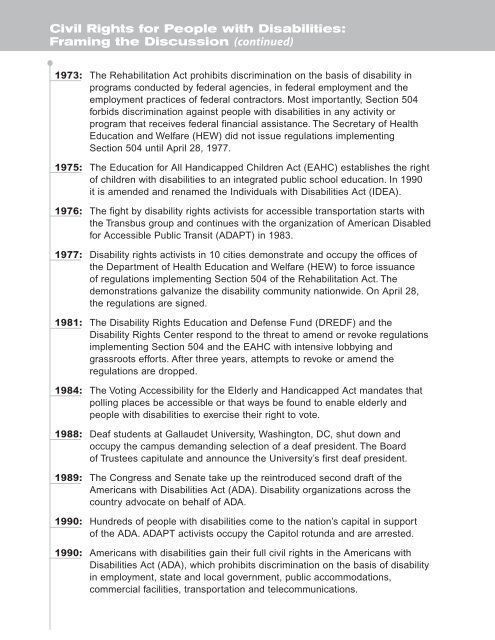Design for Accessibility: A Cultural Administrator's Handbook
Design for Accessibility: A Cultural Administrator's Handbook
Design for Accessibility: A Cultural Administrator's Handbook
Create successful ePaper yourself
Turn your PDF publications into a flip-book with our unique Google optimized e-Paper software.
Civil Rights <strong>for</strong> People with Disabilities:<br />
Framing the Discussion (continued)<br />
1973: The Rehabilitation Act prohibits discrimination on the basis of disability in<br />
programs conducted by federal agencies, in federal employment and the<br />
employment practices of federal contractors. Most importantly, Section 504<br />
<strong>for</strong>bids discrimination against people with disabilities in any activity or<br />
program that receives federal financial assistance. The Secretary of Health<br />
Education and Welfare (HEW) did not issue regulations implementing<br />
Section 504 until April 28, 1977.<br />
1975: The Education <strong>for</strong> All Handicapped Children Act (EAHC) establishes the right<br />
of children with disabilities to an integrated public school education. In 1990<br />
it is amended and renamed the Individuals with Disabilities Act (IDEA).<br />
1976: The fight by disability rights activists <strong>for</strong> accessible transportation starts with<br />
the Transbus group and continues with the organization of American Disabled<br />
<strong>for</strong> Accessible Public Transit (ADAPT) in 1983.<br />
1977: Disability rights activists in 10 cities demonstrate and occupy the offices of<br />
the Department of Health Education and Welfare (HEW) to <strong>for</strong>ce issuance<br />
of regulations implementing Section 504 of the Rehabilitation Act. The<br />
demonstrations galvanize the disability community nationwide. On April 28,<br />
the regulations are signed.<br />
1981: The Disability Rights Education and Defense Fund (DREDF) and the<br />
Disability Rights Center respond to the threat to amend or revoke regulations<br />
implementing Section 504 and the EAHC with intensive lobbying and<br />
grassroots ef<strong>for</strong>ts. After three years, attempts to revoke or amend the<br />
regulations are dropped.<br />
1984: The Voting <strong>Accessibility</strong> <strong>for</strong> the Elderly and Handicapped Act mandates that<br />
polling places be accessible or that ways be found to enable elderly and<br />
people with disabilities to exercise their right to vote.<br />
1988: Deaf students at Gallaudet University, Washington, DC, shut down and<br />
occupy the campus demanding selection of a deaf president. The Board<br />
of Trustees capitulate and announce the University’s first deaf president.<br />
1989: The Congress and Senate take up the reintroduced second draft of the<br />
Americans with Disabilities Act (ADA). Disability organizations across the<br />
country advocate on behalf of ADA.<br />
1990: Hundreds of people with disabilities come to the nation’s capital in support<br />
of the ADA. ADAPT activists occupy the Capitol rotunda and are arrested.<br />
1990: Americans with disabilities gain their full civil rights in the Americans with<br />
Disabilities Act (ADA), which prohibits discrimination on the basis of disability<br />
in employment, state and local government, public accommodations,<br />
commercial facilities, transportation and telecommunications.


